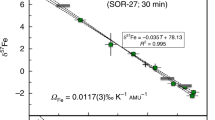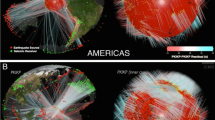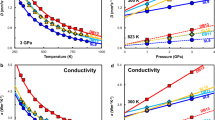Abstract
The thermal evolution of planetary crust and lithosphere is largely governed by the rate of heat transfer by conduction1,2,3. The governing physical properties are thermal diffusivity (κ) and conductivity (k = κρCP), where ρ denotes density and CP denotes specific heat capacity at constant pressure. Although for crustal rocks both κ and k decrease above ambient temperature4,5, most thermal models of the Earth’s lithosphere assume constant values for κ (∼1 mm2 s-1) and/or k (∼3 to 5 W m-1 K-1)6,7 owing to the large experimental uncertainties associated with conventional contact methods at high temperatures. Recent advances in laser-flash analysis8,9 permit accurate (±2 per cent) measurements on minerals and rocks to geologically relevant temperatures10. Here we provide data from laser-flash analysis for three different crustal rock types, showing that κ strongly decreases from 1.5–2.5 mm2 s-1 at ambient conditions, approaching 0.5 mm2 s-1 at mid-crustal temperatures. The latter value is approximately half that commonly assumed, and hot middle to lower crust is therefore a much more effective thermal insulator than previously thought. Above the quartz α–β phase transition, crustal κ is nearly independent of temperature, and similar to that of mantle materials11. Calculated values of k indicate that its negative dependence on temperature is smaller than that of κ, owing to the increase of CP with increasing temperature, but k also diminishes by 50 per cent from the surface to the quartz α–β transition. We present models of lithospheric thermal evolution during continental collision and demonstrate that the temperature dependence of κ and CP leads to positive feedback between strain heating in shear zones and more efficient thermal insulation, removing the requirement for unusually high radiogenic heat production to achieve crustal melting temperatures. Positive feedback between heating, increased thermal insulation and partial melting is predicted to occur in many tectonic settings, and in both the crust and the mantle, facilitating crustal reworking and planetary differentiation12.
This is a preview of subscription content, access via your institution
Access options
Subscribe to this journal
Receive 51 print issues and online access
$199.00 per year
only $3.90 per issue
Buy this article
- Purchase on Springer Link
- Instant access to full article PDF
Prices may be subject to local taxes which are calculated during checkout



Similar content being viewed by others
References
Thompson, W. The age of the Earth as an abode fitted for life. Science 9, 665–674 (1899)
Turcotte, D. L. & Schubert, G. Geodynamics 2nd edn, Ch. 4, 132–194 (Cambridge Univ. Press, 2001)
Petitjean, S., Rabinowicz, M., Grégoire, M. & Chevrot, S. Differences between Archean and Proterozoic lithospheres: Assessment of the possible major role of thermal conductivity. Geochem. Geophys. Geosyst. 7 10.1029/2005GC001053 (2006)
Vosteen, H.-D. & Schellschmidt, R. Influence of temperature on thermal conductivity, thermal capacity and thermal diffusivity for different types of rock. Phys. Chem. Earth 28, 499–509 (2003)
Mottaghy, D., Vosteen, H.-D. & Schellschmidt, R. Temperature dependence of the relationship of thermal diffusivity versus thermal conductivity for crystalline rocks. Int. J. Earth Sci. 97, 435–442 (2008)
Stein, C. A. & Stein, S. A model for the global variation in oceanic depth and heat flow with lithospheric age. Nature 359, 123–129 (1992)
Michaut, C., Jaupart, C. & Bell, D. R. Transient geotherms in Archean continental lithosphere: New constraints on thickness and heat production of the subcontinental lithospheric mantle. J. Geophys. Res. 112 10.1029/2006JB004464 (2007)
Degiovanni, A., Andre, S. & Maillet, D. in Thermal Conductivity 22 (ed. Tong, T. W.) 623–633 (Technomic, 1994)
Hofmann, R., Hahn, O., Raether, F., Mehling, H. & Fricke, J. Determination of thermal diffusivity in diathermic materials by the laser-flash technique. High Temp. High Press. 29, 703–710 (1997)
Hofmeister, A. M. Thermal diffusivity of garnets to high temperature. Phys. Chem. Miner. 33, 45–62 (2006)
Hofmeister, A. M. & Pertermann, M. Thermal diffusivity of clinopyroxenes at elevated temperature. Eur. J. Mineral. 20, 537–549 (2008)
Schumacher, S. & Breuer, D. Influence of a variable thermal conductivity on the thermochemical evolution of Mars. J. Geophys. Res. 111 10.1029/2005JE002429 (2006)
Hofmeister, A. M., Pertermann, M. & Branlund, J. M. in Mineral Physics (ed. Price, G. D.) 543–578 (Elsevier, 2007)
Branlund, J. M. & Hofmeister, A. M. Factors affecting heat transfer in natural SiO2 solids. Am. Mineral. 93, 1620–1629 (2008)
Pertermann, M. & Hofmeister, A. M. Thermal diffusivity of olivine-group minerals. Am. Mineral. 91, 1747–1760 (2006)
Robie, R. A. & Hemingway, B. S. Thermodynamic properties of minerals and related substances at 298.15 K and 1 bar (105 Pascals) pressure and at higher temperatures. Bull. US Geol. Surv. 2131, 1–461 (1995)
Chapman, D. S. & Furlong, K. P. in Continental Lower Crust (eds Fountain, D. M., Arculus, R. & Kay, R. W.) 179–199 (Elsevier, 1992)
Nabelek, P. I. & Liu, M. Petrologic and thermal constraints on the origin of leucogranites in collisional orogens. Trans. R. Soc. Edinb. Earth Sci. 95, 73–85 (2004)
Whittington, A. G. & Treloar, P. J. Crustal anatexis and its relation to the exhumation of collisional orogenic belts, with particular reference to the Himalaya. Mineral. Mag. 66, 53–91 (2002)
Jamieson, R. A., Beaumont, C., Fullsack, P. & Lee, B. Barrovian regional metamorphism: where’s the heat? Spec. Publ. Geol. Soc. (Lond.) 138, 23–51 (1998)
Huerta, A. D., Royden, L. H. & Hodges, K. V. The effects of accretion, erosion and radiogenic heating on the metamorphic evolution of collisional orogens. J. Metamorph. Geol. 17, 349–366 (1999)
England, P. & Molnar, P. Cause and effect among thrust and normal faulting, anatectic melting and exhumation in the Himalaya. Spec. Publ. Geol. Soc. (Lond.) 74, 401–411 (1993)
Harrison, T. M., Grove, M., Lovera, O. M. & Catlos, E. J. A model for the origin of Himalayan anatexis and inverted metamorphism. J. Geophys. Res. 103, 27017–27032 (1998)
Nabelek, P. I. & Liu, M. Leucogranites in the Black Hills of South Dakota: The consequence of shear heating during continental collision. Geology 27, 523–526 (1999)
Liu, M. & Furlong, K. P. Crustal thickening and Eocene extension in the southeastern Canadian cordillera: Some thermal and mechanical considerations. Tectonics 12, 776–786 (1993)
Patiño-Douce, A. E. & Harris, N. Experimental constraints on Himalayan anatexis. J. Petrol. 39, 689–710 (1998)
Hartz, E. H. & Podladchikov, Y. Y. Toasting the jelly sandwich: The effect of shear heating on lithospheric geotherms and strength. Geology 36, 331–334 (2008)
Pertermann, M., Whittington, A. G., Hofmeister, A. M., Spera, F. J. & Zayak, J. Transport properties of low-sanidine single-crystals, glasses and melts at high temperature. Contrib. Mineral. Petrol. 155, 689–702 (2008)
Hofmeister, A. M., Pertermann, M., Branlund, J. M. & Whittington, A. G. Geophysical implications of reduction in thermal conductivity due to hydration. Geophys. Res. Lett. 33 10.1029/2006GL026036 (2006)
Annen, C., Blundy, J. D. & Sparks, R. S. J. The genesis of intermediate and silicic magmas in deep crustal hot zones. J. Petrol. 47, 505–539 (2006)
Acknowledgements
We thank M. Liu for providing the original version of the program OROGEN. This work was supported by the US National Science Foundation.
Author information
Authors and Affiliations
Corresponding author
Supplementary information
Supplementary Table
This file contains a Supplementary Data Table (XLS 24 kb)
Rights and permissions
About this article
Cite this article
Whittington, A., Hofmeister, A. & Nabelek, P. Temperature-dependent thermal diffusivity of the Earth’s crust and implications for magmatism. Nature 458, 319–321 (2009). https://doi.org/10.1038/nature07818
Received:
Accepted:
Issue Date:
DOI: https://doi.org/10.1038/nature07818
This article is cited by
-
Rapid accumulation and ascent precedes caldera forming eruption of low viscosity magma
Contributions to Mineralogy and Petrology (2024)
-
Metastable liquid immiscibility in the 2018–2021 Fani Maoré lavas as a mechanism for volcanic nanolite formation
Communications Earth & Environment (2023)
-
Crustal remelting origin of highly silicic magmatism on the Moon
Communications Earth & Environment (2023)
-
Thermal evolution of a Variscan syn-orogenic intracontinental basin (Servoz basin, Western Alps): RSCM geothermometry and geochronology
Swiss Journal of Geosciences (2022)
-
Mineralogical and fluid inclusion constraints on the formation of the Karakorum Migmatite: implications for H2O-fluxed melting and exhumation of the South Tibetan Crust
Contributions to Mineralogy and Petrology (2022)
Comments
By submitting a comment you agree to abide by our Terms and Community Guidelines. If you find something abusive or that does not comply with our terms or guidelines please flag it as inappropriate.



